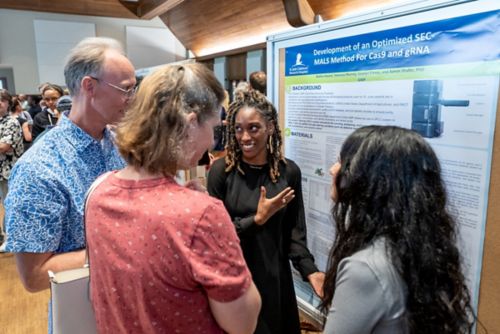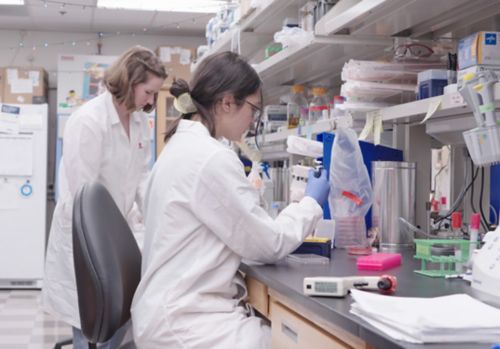St. Jude Family of Websites
Explore our cutting edge research, world-class patient care, career opportunities and more.
St. Jude Children's Research Hospital Home

- Fundraising
St. Jude Family of Websites
Explore our cutting edge research, world-class patient care, career opportunities and more.
St. Jude Children's Research Hospital Home

- Fundraising
Student mentors add an extra level of support to High School Research Immersion Program

Group photo featuring the 2024 high school research immersion participants, their mentors, student mentors and program administrators.
Many of the world's most accomplished and influential figures attribute a substantial portion of their success to their mentors, underscoring the profound impact of these relationships. For instance, Plato, one of history's most renowned philosophers, was mentored by Socrates, whose teachings and mentorship were instrumental in Plato's intellectual development. Similarly, in modern business, Bill Gates, the co-founder of Microsoft, has often credited his mentor, Warren Buffet, with crucial advice and wisdom that helped shape his business strategies. Mentorship can catalyze personal and professional growth, offering perspectives and opportunities that might otherwise remain out of reach.
The St. Jude STEMM Education and Outreach Program enables upcoming high school seniors to participate in a mentored research experience. The high school research immersion (HSRI) program provides a hands-on experience working in a St. Jude lab for the summer. Throughout the program, the students learn professional and research skills, getting a glimpse into the career of a research scientist, both translational and clinical.
While the program pairs each participating student with a St. Jude employee as their mentor, a pilot launched in the summer of 2024 added undergraduate college student mentors as an added level of support. These trained near-peer mentors help guide high school students throughout the summer research experience. This initiative shares mentorship and training responsibilities between student mentors and principal investigators making it easier for principal investigators to provide ongoing support to students in their labs throughout the program.
The student mentor pilot
The Emerging Leaders in Biomedical Research (ELBR) program runs the new student mentor initiative. During the spring semester, the mentor assistants participate in monthly leadership training in preparation for working with the students during the summer HSRI program.
Gwen Alexander, PhD, STEMM Education and Outreach, HSRI Program Manager, piloted the program after recognizing the need for additional mentoring support. “The mentor assistant program was piloted in eight labs this summer, based on past feedback from mentors, Alexander said.
“It provided another resource to help mentors support their students while continuing to conduct the regular operations of their laboratory during the HSRI’s eight-week duration.”
By placing undergraduate students as mentors in the labs, the initiative enhances the mentorship of new HSRI students, aiding their acclimation and skill development while allowing principal investigators to delegate some training responsibilities. This ensures consistent support for all students, offers undergraduate mentors leadership experience, fosters collaboration, and promotes effective teamwork.
The commitment to mentorship
Training students without prior experience in a research lab can be demanding. It involves a significant investment of time to cover everything from general lab safety to standard laboratory techniques. When balancing the responsibilities of running a lab, such as writing grant proposals, managing lab staff, and handling various administrative tasks, bringing on two new students over the summer may seem overwhelming.

(L to R) Aaron Shafer, PhD, St. Jude Good Manufacturing Practices (GMP) Facility, hears from Vanessa Murrey and Mahin Hasani, students in the St. Jude High School Research Immersion Program, about their summer research project.
Aaron Shafer, PhD, analytical development scientist, St. Jude Good Manufacturing Practices (GMP) facility, talked about the commitment required for effective mentorship in a laboratory environment, “It takes a significant amount of effort upfront to provide the students with ample background and context about their project so they can truly engage with the data and enjoy the process,” Shafer said.
“But as you establish your curriculum and better understand how to train mentees, it becomes more manageable to have students in the lab. It helps to have support to balance your work and effectively provide mentorship.”
Shafer’s lab was one of the eight to have a student mentor this summer. He described the impact of their work, "Joselyn [student mentor] was integral in preparing the first few lectures for the students, allowing me to focus on other tasks.”
“She gave lectures, went over standard operating protocols (SOPs), and would go through the answers to different questions. Having her here and managing the students’ day-to-day was a big deal.”
Shafer has already started planning how to optimize working with a student mentor next year. “If I get another mentor assistant, I’ll focus on training them more on the equipment, especially since I’ve now documented most of the experiments,” he said. “With this major time investment already made, we can concentrate on equipment training using the experiments I've prepared.”
The role of student mentors
The student mentors serve as peer guides, teaching HSRI students new lab techniques and supervising project progression. They provide enhanced support and guidance and increase the students’ comfort and confidence in the laboratory environment. In turn, there is a more manageable distribution of mentorship responsibilities and improved efficiency and effectiveness in student support for the principal investigator and lab staff.

(L to R) Cydney Johnson, PhD, a postdoctoral research associate in the Department of Host-Microbe Interactions, and Roari Lopez-Conover, a High School Research Immersion student, both received support from an undergraduate student mentor throughout the summer.
Joselyn Pierce, student mentor and undergraduate student at the University of Memphis, explained her role in the lab. “My role is to connect the high school students and senior staff. I help bridge the gap by translating and explaining ideas between both sides. If students don't understand the mentor's language, I clarify for them and vice versa,” she said. “Being closer to the student's age, I can better relate to their knowledge level and build on it to clarify complex concepts.”
The student mentorship model fosters strong near-peer interactions that are highly effective and mutually beneficial for both the undergraduate and high school students. In addition to working alongside someone with similar interests and experiences, increased motivation and confidence, emotional support, and approachability are large benefits for high school and undergraduate students, particularly when immersed in mentored research programs such as the HSRI.
Ryan Vera, an incoming freshman at the University of Tennessee at Knoxville, described what he had learned. "Even though I was in the role of student mentor, I was still learning with the mentees," he explained. "But I feel like I learned more outside of the research itself. I gained insights into how my mentees think and react to various situations, which taught me valuable lessons about leadership."
This program shows that mentorship is not limited to a novice-expert relationship. Transformative experiences and impactful learning can also flourish among near-peers who exchange knowledge and support one another.
Professional peer networks develop through mentorship
Research shows that students perform better when not the only novices in the room, and student mentors provide an additional layer of comfort. While their primary role is to assist the principal investigator in training and supervising, their close age to the HSRI students helps establish rapport and friendships, enriching the mentoring experience and expanding their professional peer network.
Lauren Demery, a Lausanne Collegiate School student participating in the HSRI, described her evolving friendship with her student mentor, “At the beginning of this program, Ryan [student mentor] was a stranger to me, but throughout these eight weeks, I learned that he is really kind, and, aside from being my mentor assistant, he's my good friend.”
The promising pilot
St. Jude introduced the student mentor initiative to simplify the mentoring process for principal investigators during the HSRI. Still, it has evolved into a powerful program that benefits student mentors and HSRI participants. This initiative not only enriches students’ experiences in the HSRI but also enhances the leadership skills of the student mentors while reducing the load for principal investigators.
Alexander described the program’s overall performance throughout the summer. “This triad model, where the undergraduates were positioned as aids to the mentors and helped oversee high school student pairs, was quite effective this summer, she stated. “Mentors shared positive feedback related to their productivity while facilitating the mentored experiences. It holds promise for long-term benefits, fostering growth and collaboration within the program.”
Interested in becoming a mentor?
The STEMM Education and Outreach Department is currently recruiting scientists to serve as mentors for the 2025 HSRIP summer experience. Scientists interested in serving as a mentor in the program who would like to have a mentor assistant in their lab should email immersion@stjude.org or gwen.alexander@stjude.org.






